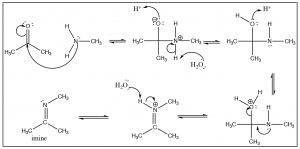7.9: Reactions with Nitrogen Nucleophiles
- Page ID
- 354436

There is a similarity between the reactions of oxygen nucleophiles and nitrogen nucleophiles. For example, let us look at the reaction of a primary amine with a ketone. The mechanism begins in the same way with the nucleophile(N) attacking the carbonyl to form a tetrahedral intermediate, which can undergo various reversible protonation/deprotonation reactions until an intermediate is formed that can collapse down to a new product with a \(\mathrm{C=N}\) function—which is called an imine. It is the nitrogen analog of the ketone and behaves in much the same way.

There are many other nitrogenous nucleophiles that can react with aldehydes and ketones, for example hydroxylamine (\(\mathrm{NH}_{2} \mathrm{OH}\)), or hydrazine (\(\left(\mathrm{NH}_{2} \mathrm{NH}_{2}\right)\)) or a whole range of substituted hydrazines, all react with aldehydes and ketones to produce the corresponding imine.

Generally, we do not see the nitrogen analog of an acetal, the intermediate is unstable and reacts to form the imine. However, in the case of a secondary amine, the reaction proceeds in exactly the same way until the imine stage—with the one difference that the nitrogen is now in the quaternary state (an iminium ion). Instead of addition of another amine, a proton is removed to produce a new functionality, the enamine.
A note on how these reactions proceed:
While these mechanisms may seem complex with many steps, those individual steps are very similar. Students often ask how they can know which way the reaction goes, and the way we write out mechanisms does tend to give the idea that each step is marching purposefully along like clockwork—from one intermediate to another as if the molecules had an “end goal” in sight. Nothing could be further from the truth: each step in the reaction, each protonation and deprotonation, and each nucleophilic attack and loss of a leaving group is occurring all at the same time in a stochastic and chaotic fashion. However, we can control the reaction as discussed earlier by using Le Chatelier’s principle[5]: adding reactants or removing products can shift the position of equilibrium to produce the product that we are after.


